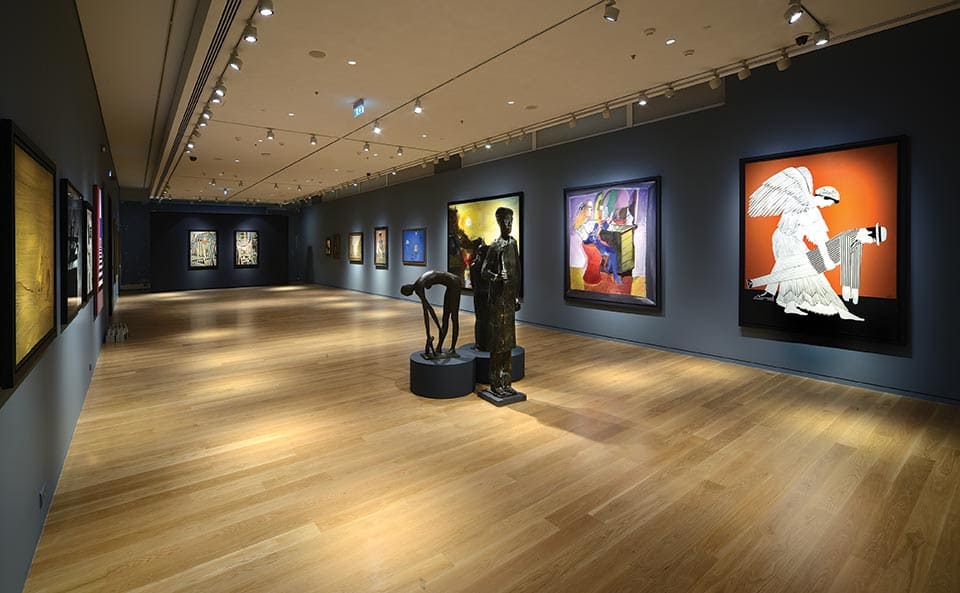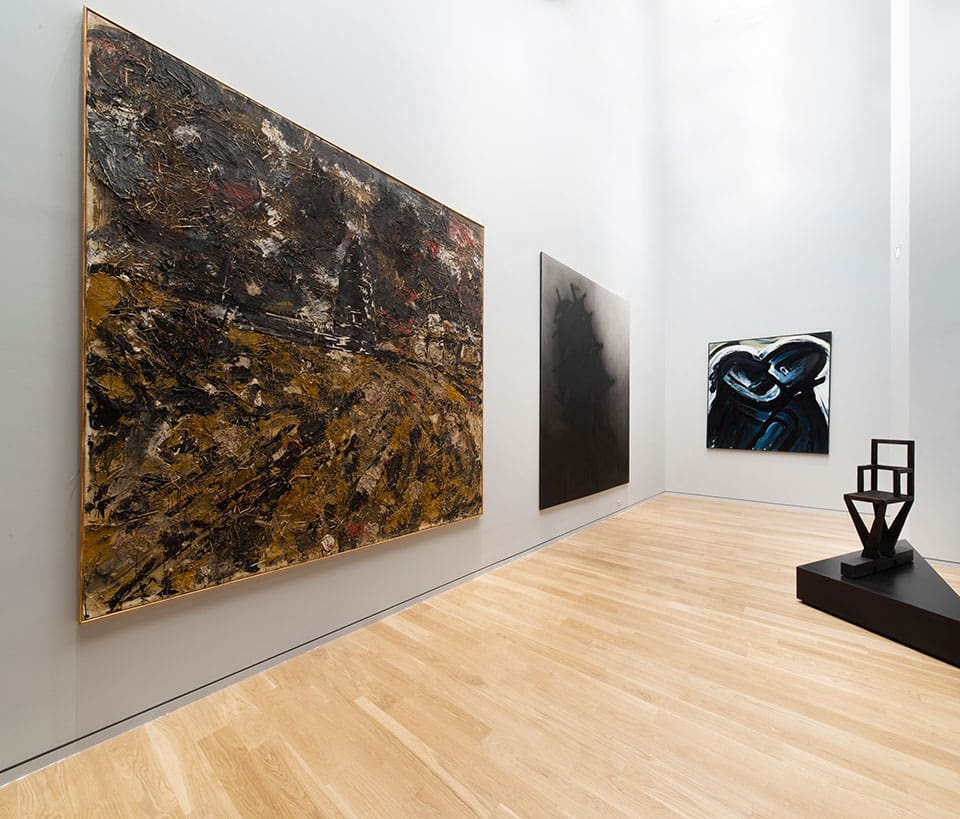A Modern Art Overview in Athens: An expansive and impressive collection
George Micallef Eynaud explores the newly opened Goulandris Museum of Modern Art in Athens
Walking down Eratosthenous Street in Athens’ trendy Pangrati district, past the hustle and bustle of store fronts and traffic jams, one is quickly confronted by a most incongruous building. It consists of a typically grand neoclassical townhouse, of the type still found scattered across the city centre, topped with what seems like a modernist construction airlifted out of another dimension.

Basil & Elise Goulandris Foundation © Christophoros Doulgeris

Basil & Elise Goulandris Foundation © Christophoros Doulgeris
Even if someone had this kind of money, they would never come across these works. They are no longer on the market.
Resembling, from certain angles, the bow of some futuristic ocean-liner rising above the drowsy Athenian rooftops; this contemporary construction (work on which began back in 2012, with designs by the local architectural firm Ι. & Α. Vikelas and Partners) as well as the listed mid-war building to which it is attached, houses the Basil and Elise Goulandris Foundation’s collection of art across four floors of dedicated gallery spaces. The entire building, which will also host a rotating programme of temporary exhibitions, consists of eleven stories, five of which are below ground.
The Greek modern artist Pavlos (born Pavlos Dionysopoulos in 1930) once said of the stunning art collection amassed by Greek shipowner Basil Goulandris, who died in 1994: “even if someone had this kind of money, they would never come across these works. They are no longer on the market”.
Beginning in the 1950s, Basil and his wife and lifetime companion Elise amassed a collection relatively unparalleled in recent history, certainly on a local scale – no small feat given the rich heritage of art patronage among Athens’ moneyed shipping set. The collections represent autograph masterpieces by such titans of twentieth-century art as Pablo Picasso, Marc Chagall, Henri Matisse, Alberto Giacometti, Auguste Renoir, Joan Miro, Paul Klee and Wassily Kandinsky, among others.

Amedeo Modigliani, Caryatid, c. 1914, pencil and gouache on paper laid down on canvas, courtesy of Basil & Elise Goulandris Foundation
Basil and Elise, who counted many of the artists whose work they would go on to collect among their friends and acquaintances, built up his collection over a long and cosmopolitan life spent mainly among Athens, Paris, Lausanne, Gstaad – where priceless modernist masterpieces hung upon the wooden walls of their chalet – and the bewitchingly beautiful island of Andros in the Aegean Sea, where they opened a museum of modern art in 1979, a relatively unique endeavour in Greece at the time. Always returning to their beloved Greece, the couple sought inspiration and advice among local artists and actively promoted new and emerging talent, fostering in a new generation of experimental practitioners whose first brush with the modern avant-garde came – in a time before instant Internet access or even easily available art publications – from their encounter with the original museum and daring programme of exhibitions the collectors devised there, ranging from Van Gogh to Picasso to Balthus.
Following the construction of the museum on Andros, the couple wanted to see a second institution host the collection in Athens. While work on the project began in their lifetimes, they sadly did not live to see the finished museum come to fruition. Their generous nature, inquisitive spirit and, above all, enduring love of art live on for posterity through the foundation that bears their name, and their life-long mission of bringing the very best of modern art to their homeland, and the country that provided so much inspiration through its beauty and history, has come full-circle.
Among the masterpieces held by the foundation is Edgar Degas’ beguiling bronze sculpture Little Dancer of Fourteen Years (1880-1881). This is one of sixty-nine bronze casts of this iconic master-work of impressionistic sculpture that remain today, after Degas’ wax original. Paintings from the same period represent watershed moments in the development of art, such as Paul Cezanne’s proto-Cubist canvases, an intense self-portrait and landscape entitled La Campagne d’ Auvers sur Oise (1881-1882), as well as an example of Claude Monet’s celebrated series of studies of light upon Rouen Cathedral at various times of day (1894).
Paul Gauguin’s Nature Morte aux Pamplemousses (1901-1902) effortlessly conveys an evocative mood of tropical malaise and a yearning for new horizons, while his tumultuous relationship with Vincent Van Gogh could be better understood through the prism of the Dutch artist’s more intense view of reality as displayed in his 1888 painting Nature Morte Cafetiere, a milestone in the artist’s use of brilliant, pure colour.
Another grandstanding friendship of modern art is represented courtesy of Pablo Picasso’s Femme Nue aux Bras Levés from 1907, a unique and historically-critical work that acts as a precedent to the artists era-defining early masterpiece Les Demoiselles d’Avignon, hanging alongside Georges Braque’s La Patience (1942). The key differences between Picasso and Braque, early friends and pioneers of Cubism, can be directly felt through these two works – Picasso’s violent tendency to strip reality back to its core by reconfiguring appearance contrasted with Braque’s somewhat more leisurely meditation on the joys of seeing and playful approach to composition, which is echoed again in Fernand Leger’s Elements Mecaniques (1919) and Joan Miro’s Paysage (1942), a luminously beautiful work that not only approaches, but surpasses, pure abstraction.
Other highlights include a stunning Veil of Veronica from the early 1580s by El Greco (it is only fitting that this historical master, and true precursor to modern expressionism, should return to transfix generations of art lovers on his home turf). Alberto Giacometti’s emaciated figure Femme de Venise (1956) and Francis Bacon’s Three Studies for a Self Portrait from 1972 strike an existential tone that is offset by Pierre Bonnard’s characteristically sensuous depiction of his wife getting out of her bath, filled with the warm-glow of the Mediterranean light. The collection carries on into a new age of possibility with Jackson Pollock’s Number 13 (1950), seeming to reconfigure an entire history of looking into something new and unknown, perhaps even dangerous, the logical end of painting.
Basil and Elise Goulandris would not have had it any other way. Never content to rest on their laurels, they continued searching for beauty and meaning through art. Always inquisitive, always taking risks, throughout their lives. This museum will remain a testament to their journey for generations yet to come.
www. goulandris.gr/










